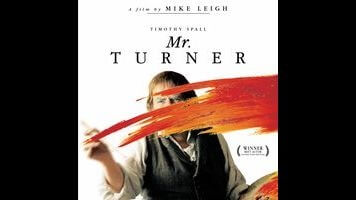On his deathbed in the winter of 1851, the great landscape painter J.M.W. Turner is said to have uttered four parting words: “The sun is God.” Whether this was really the last sentence spoken by Turner is a question to put to the historians, but it certainly sounds like something he could have said with his final breath. For the so-called “painter of light,” the sun was God—a giver of daily illumination, without which he could have neither seen the world nor immortalized its natural wonders. Mr. Turner, which coincidentally opens Stateside on the 163rd anniversary of its subject’s death, entertains the veracity of that famous quote. Not only that, it presents a version of Turner unusual enough to have bid farewell with such a brief but grandiose remark. Written and directed by British master Mike Leigh (Naked, Another Year), the film is a portrait of the artist as visionary oddball, for whom life was an endless source of both beauty and the irritating distractions blocking his view of said beauty.
One of those distractions, incidentally, was Turner’s own family, and it’s to the credit of this lush, lengthy biopic that the painter’s most callous tendencies—like an apparent refusal to even acknowledge the existence of his offspring in mixed company—are never sugarcoated. As embodied by squat English character actor Timothy Spall, Turner is a mess of contradictions: He can create works of deep splendor and sensitivity, but seems incapable of treating his long-term housekeeper (Dorothy Atkinson) as anything but a recipient of his commands and sexual whims. Bad behavior aside, it’s an endlessly entertaining performance; sometimes speaking in nothing but emphatic grunts, Spall imbues the role of his lifetime with both crankiness and warmth, playing the artist as a distant, preoccupied eccentric too wrapped up in his calling to devote much energy to social niceties.
For Leigh, however, Mr. Turner is less a revelation than a return to familiar territory, the bustling 19th-century England of his previous biopic, Topsy-Turvy. Just as he did in that whirligig backstage pass, the filmmaker has applied his usual process—work-shopping the characters with his cast for months in advance, then writing the script around the drama they improvise—to real-life subjects. There’s something inherently exciting about seeing Leigh’s off-kilter sensibility in the context of a handsome period piece, and the alternately lavish and grungy environmental detail provides its own singular fascination. If Mr. Turner isn’t quite as dazzling as Topsy-Turvy, it’s because Leigh has taken a broad view instead of productively limiting his focus to one chapter or aspect of the biography. He’s made a more conventional biopic, albeit one blessedly unconcerned with connecting Wikipedia bullet points with a single thematic through-line.
Focusing on roughly the final two decades of Turner’s life, Leigh offers a two-and-a-half-hour series of colorful episodes, animated by research and anecdote. The artist is seen sparring with contemporaries, among them the financially troubled historical painter Benjamin Haydon (a terrifically hysterical Martin Savage), and weathering the fickle interest of critics and the public. (As several wildly funny scenes indicate, the art world has always been dominated by gossip and celebrity.) For all his cantankerous indifference, Turner is depicted as a man prone to sudden flares of great sentiment—wheezing and blubbering, for example, over the beauty of a young prostitute he attempts to paint. Eventually, he tiptoes into a romance with a Margate widow (Marion Bailey), the woman with whom he would spend his august years, and the movie gains a measure of tender pathos.
One benefit of the extended timeline is the ability to convey the ebb and flow of a career; by film’s end, Turner’s immense popularity and acclaim has faded, even as his proto-Impressionistic work proves a quiet influence on a new generation of painters. Once an early camera makes a late appearance, it’s clear that Leigh is building toward a eulogy—not just for his Great Man protagonist, but for the mode of artistic expression he arguably perfected.
Given the material, it’s fitting that Mr. Turner is the director’s most visually ravishing movie. With cinematographer Dick Pope behind the lens, every shot is gorgeous enough to hang in a museum, beginning with the opening image—a striking long take of a windmill at sunset, the camera following a pair of chatty passersby, then belatedly landing on Turner as he puts the view to paper. There’s purpose, beyond dropping jaws, to such glorious sights: While Leigh largely neglects to explore the nitty-gritty of his subject’s creative process, the glowing interiors and spectacularly colorful exteriors make it obvious that he never lacked for scenic inspiration. Mr. Turner doesn’t transform the biopic the way Mr. Turner did the canvas, but it does, in its greatest moments, capture some of the divine magnificence the man saw in the world around him.









































